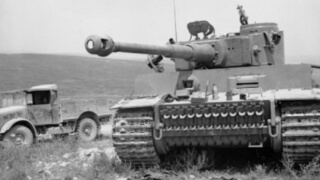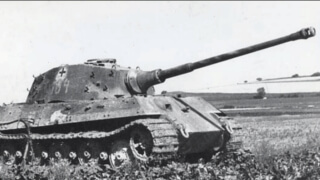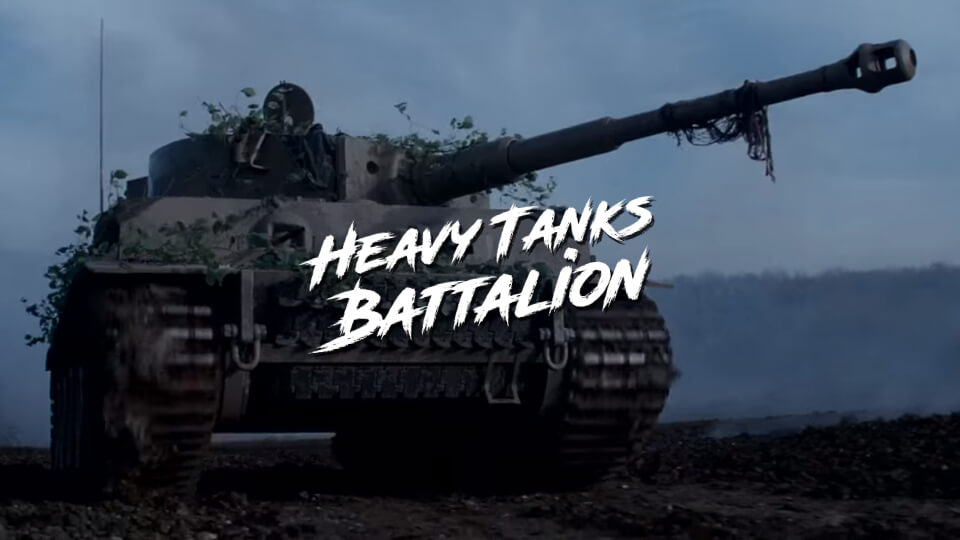The Tiger I and Tiger II tanks were arguably the most formidable heavily-armored tanks in the Second World War but did not come into existence until 1942. After Germany lost World War I to the Allied Forces in 1918, their army came up with solutions to the armament problems they had faced in the war by developing a new combat strategy. This strategy involved the use of heavily-armored vehicles to break their enemy's defensive lines and lighter and faster tanks to take advantage of this breach to encircle the enemies' forces. It had become clear to them that the next war wouldn't be fought solely in the trenches but one that heavily relied on armored vehicles.
A salient feature of the Second World, armored warfare was viewed as the defining factor as to who would win and lose. Countries, therefore, employed all manner of tanks, reconnaissance vehicles, and armored vehicles. Germany set the bar for heavily-armored tanks high by designing the Tiger I and II models that were a game changer. After facing the Tiger tanks in combat in 1942, both the Axis and Allied Forces were impressed with the German tanks’ performance and had to redesign their heavy tanks to be at par.
DEVELOPING THE TIGER I
Germany entered late in the development of heavy tanks because the army was confident that the formerly mass-produced Pz. Kpfw.III and IV would be adequate for the anticipated wars but in 1937, with the guidance of Heinz Guderian, Germany's war theorist, the operational development of the Durchbruchswagen, the breakthrough tank, began. The goal was simple- to engage and annihilate the opponent's artillery, hence penetrating the enemy's defensive lines. This concept was centered mainly on the offensive. However, the project lapsed until 1941, when it was evident that the Panzers, Pz. Kpfw. III and IV had not been as successful as had been expected against the British and French tanks in 1940. Production of the massive tanks was fully endorsed when the German KV-1 tanks faced the impressive Soviet's T-34's in 1941. This encounter resulted in planning and ordering for a heavy tank that would mount an 88mm high-velocity gun in a turret with full navigation power, and that would carry enough armor to crush enemy's anti-tank weapons. Germany was now all in.
Two firms, Porsche and Henschel & Sohn, submitted prototypes using the 1937 specifications. They both had a standard turret that had been designed by Krupp. The German Army staff chose the Henschel & Sohn prototype for production after a series of tests conducted on April 20th, Hitler's birthday. This decision was based on the fact that the Henschel prototype was cheaper, had greater maneuverability and was simpler to produce than the Porsche prototype, VK 4501(P), which was considered extravagant as it required copper, which was limited in supply, to manufacture its drivetrain parts.
Tiger I proved to be a force to reckon with as it had great successes in open combat that the Allied Forces were afraid to face it in the field.
Design
The Tiger tank's design was not completely different from earlier German models. It was especially similar to the Panzer IV. However, it weighed twice as much as other tanks due to its significantly thicker armor, its bigger engine and main gun, more fuel capacity and ammunition compartment as well as a denser suspension.

Main gun
In 1941, Rheinmetall AG was contracted to design a turret with a gun that could penetrate 140mm of armor at a range of 1000 meters. The German general staff provided these specifications. The first weapon to be designed was the 75mm KwK L/60 that did not meet the requirements. It could only penetrate armor 100 mm thick at a range of 1400 meters, when inclined at 30 degrees. To meet the penetration specification, Rheinmetall manufactured the 75mm KwK 42 L/70gun. The longer gun was to be fitted with a new turret. It was decided that the first 100 tanks would mount the 88mm KwK 36 L/56 in the Krupp turret then the rest of the newly manufactured tanks would mount the75mm KwK 42 L/70 onto the Rheinmetall's turret. However, there was a meeting of the German General Staff on 14th July 1942, and it was agreed upon that the 88mm KwK 36 L/56 could also penetrate 100mm of armor, and therefore conversion to the75mm KwK 42 L/70 gun was unnecessary. They decided, however, to conversion to the 88mm KwK L/71 at the end of 1942. These changes in length and design of the armor piercing ammunition by decreasing the explosive filler cavity resulted to increased penetration power. This gun was highly accurate, and with excellent optics, it could hit targets at extreme ranges of over 1200 meters that the opponents could not even aim at. Simply put, this gun outshot and outranged the Allied Forces' guns.
NB: 88 KwK 42 L/70 means that the diameter of the caliber of the gun was 88 mm, KwK implies that the firearm is Kampfwagenkanone (a Tank Gun), the weapon was developed and assembled in 1942 (hence the “42”) and that its length was 70 times the diameter of the bore (caliber).
The 88mm KwK 36L/56 turned out to be the best gun for a heavy tank such as the Tiger I and was employed as its main gun. This gun gave the Tiger I significant advantage over other tanks not only regarding penetration but also due to its high muzzle velocity and provision of a higher margin of error. The shooter didn’t need to be another Rob Furlong in order to fire a successful shot.
Ammunition
The Tiger I could carry about 92 rounds of ammo. Half of this being the Armor Piercing Capped, Ballistic Capped (APCBC) and the rest being, HE, High Explosive shells (Sprenggranaten). There were also a few rounds of the Armor Piercing Composite Rigid, APCR, which were made of tungsten carbide. These were saved to be used against the most massive tanks and tank destroyers such as the Russian tanks.
Maneuverability
Despite its weight and size, the Tiger I was reasonably maneuverable. However, it required frequent maintenance routines to keep it up and running. Without this, the tank would breakdown resulting in its abandonment and destruction by the crew. The Tiger I was also among the fastest German tanks. Its speed could only be compared to that of its predecessor, the Panther, which was a bit faster.
The Tiger tank engine like other medium and heavy German tanks was designed and developed by Maybach-Motorenbau GmbH. The engine, Maybach HL 210P45, was a V-12 water-cooled gasoline driver that could hold up to 21 liters and had a power output of 650 bhp at 3000 rpm.
Armor
The Tiger I was made from the best quality rolled German nickel-steel plate armor that was electro-fused into interlocking sheets. It was not as well-sloped as the Soviet Union's T-34 but was far more resistant due to its 80 mm thick armor plate. It had a Brinell hardness index of around 270 and meticulous quality control practices guaranteed that the armor's qualities did not waver. Because of its resilience, when a tank was hit and damaged by the enemy's shells, the crew was able to destroy the tank and escape without sustaining any injuries. Hence, the German Army personnel had a lot of war experience.
DEVELOPING THE TIGER II
Hardly had the Tiger I been placed in service than the German General Staff demanded a replacement. They wanted a tank with superior qualities to anything the Soviet Union could produce. Their point of view was that, since armored warfare was fast evolving, they needed to stay ahead of the pack by having improved designs each year. In January 1943, Hitler asked Porsche and Henschel and Sohn to come up with models that incorporated the 88mm Flak 41 and that had the newest sloped armor. There was, however, a sensitive issue at hand: Krupp was to mount a rival's gun onto their turret, something that did not sit well with them. Regardless, in the end, Krupp was also awarded the contract to develop their gun, the 88mm KwK 43 L/71. This gun had the same penetration values as Rheinmetall's Flak 41 but all other characteristics were different. It was shorter than the Flak 41 and had a different rifling system.
This time around, Porsche was so sure they’d win the contract to manufacture the new tanks that they placed an order for 50 turrets from Krupp. However, since they were still incorporating electric engines, their ideas were rejected due to limited copper supplies and the contract went once again to Henschel. But since there were 50 turrets already, these were mounted on the first 50 Henschel designs. These turrets had many deficiencies, did not offer any protection and carried fewer rounds of ammunition. Krupp modified these designs eliminating those errors and the newly-designed turrets did not have these problems. The tanks were officially designated the names Panzerkampfwagen Tiger Ausf. B and Panzerbefehlswagen Tiger Ausf. B(this was assigned to the command models).
Design
The new turret had a frontal plate made of compounded nickel and steel that was 180mm thick and was inclined at 10 degrees from the vertical. Its roof was 40mm, and its sidewalls were 80mm. The glacis shield was 150mm thick and was inclined from the vertical by 50 degrees; this offered a total thickness of 230mm that rendered it almost impervious to the enemy's shells. It is said that the British 17 Pounder could supposedly pierce the frontal armor when using special ammunition. However, there is no proof of this armor ever being penetrated in the frontline. The armor was slanted like that of Soviet's T-34, and welded just like its predecessor's, Tiger I. Because of the sloping and thickness of the armor, the shells that hit the tank, ricocheted instead of piercing it.
Main gun
The gun mounted on the Tiger Tank II was the long and powerful 88mm KWK 43 L/71. It was developed in 1943. It had impressive penetration power and outranged all Allied main guns. It had a monocular Turmzielfernrohr which was affixed parallel to the gun; one could set the magnifications to allow for precise shooting even in long ranges.
The tank carried 86 rounds of ammunition half of them being APCBC and the rest being Highly-explosive ammunition. There were also few APCR rounds that were used against heavily-armored vehicles such as the Soviet tanks and tank destroyers.
Mobility
Many reports have claimed that because of its large size the Tiger II was the slowest tank in the War. These are unfounded claims because according to test reports from units that used the tanks in the war, with a maximum speed of 42km/h, the tank was faster than most German and Allied tanks. However, the tank needed frequent maintenance tests to keep it up and running and failure to do this resulted in the breakdown of the machines. The tank served in the famous battle of Normandy, in operations in Poland, Minsk, Hungary and in Berlin too. Despite its advantages, it consumed lots of fuel, and this proved to be a significant hindrance as most tanks were abandoned due to lack of fuel rather than destruction.

On the one hand, the Tiger dominated the battlefield due to its ingenious engineering and set the standards on heavy-armored vehicles upon which other countries in the world tried to emulate and build on. On the other hand, both models of the Tiger Tanks were maintenance- intensive and very costly to produce. These costs were too much for Germany since they manufactured very few tanks by the end of the war compared to their counterparts. By June 1945, only 492 Tiger II units had been produced and 1347 Tiger I units before their replacement. Comparing these figures to the Allied Forces tanks, Germany, no matter how excellent their productions, could not stand against their enemy. It seems that when fighting a world war, good enough just isn’t good enough. For instance, America built 49,234 M4 Sherman tanks in the Second World War. The tanks were built to destroy enemy heavy tanks during offensive missions; which they did.
Nevertheless, the Tiger tanks are something that certainly comes to mind when you think about Germany’s involvement in World War II.

